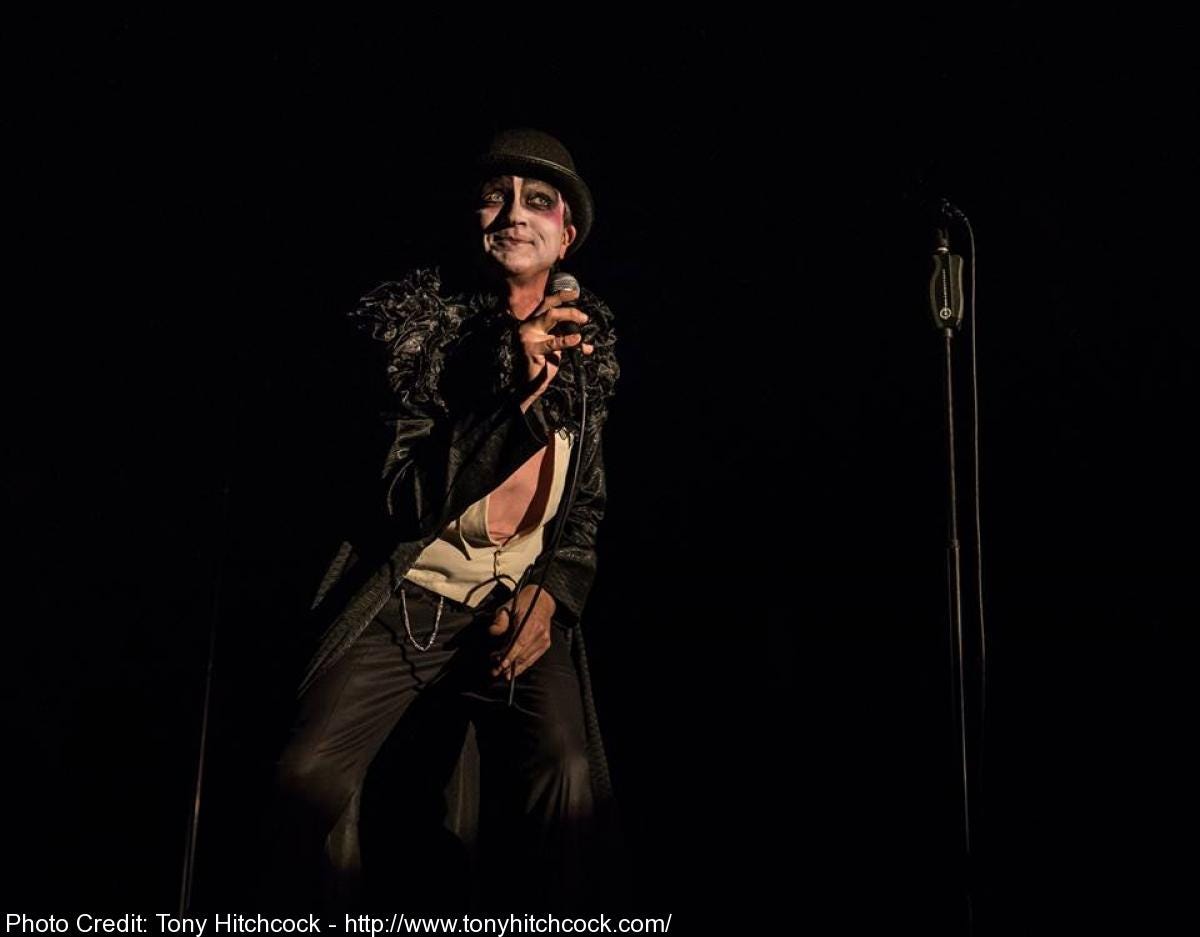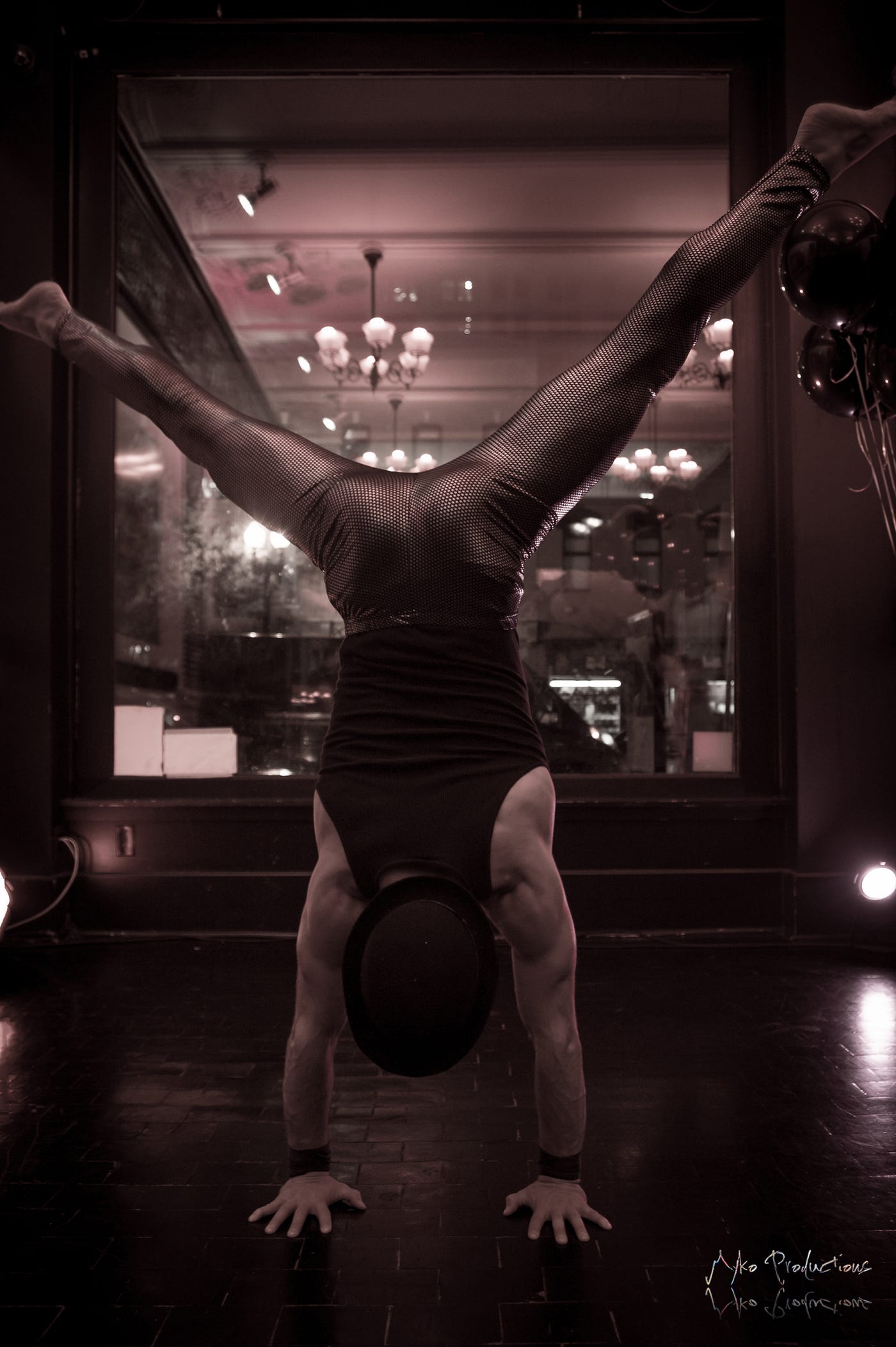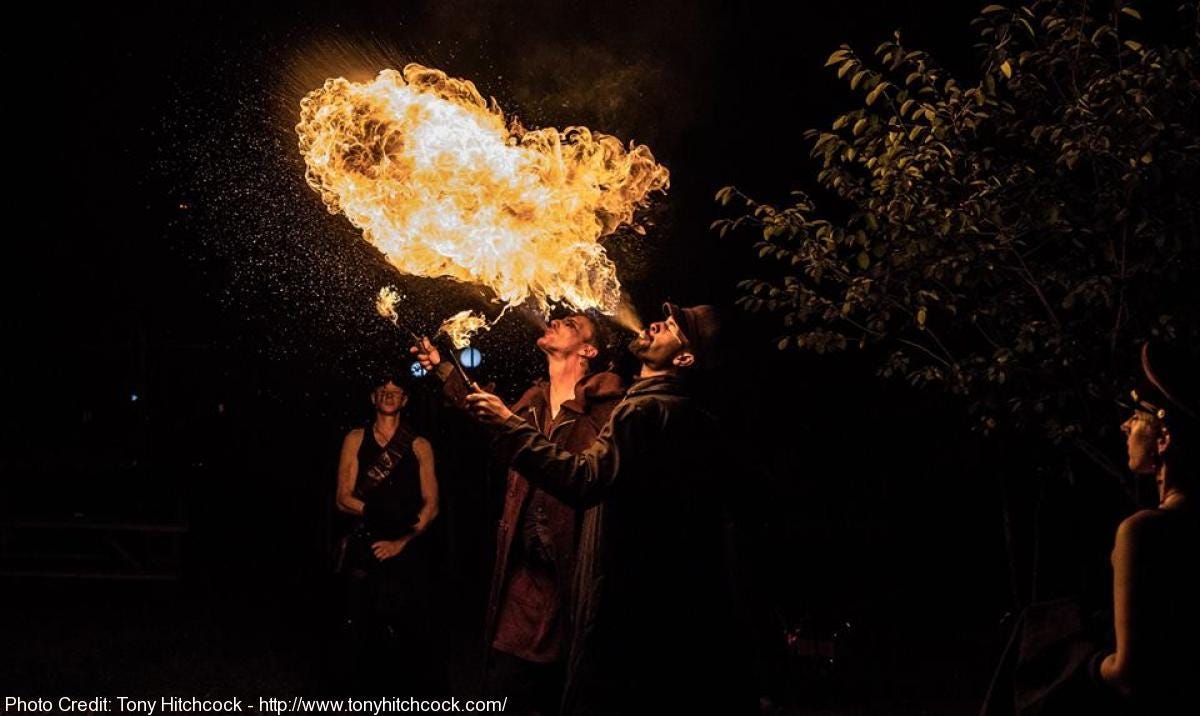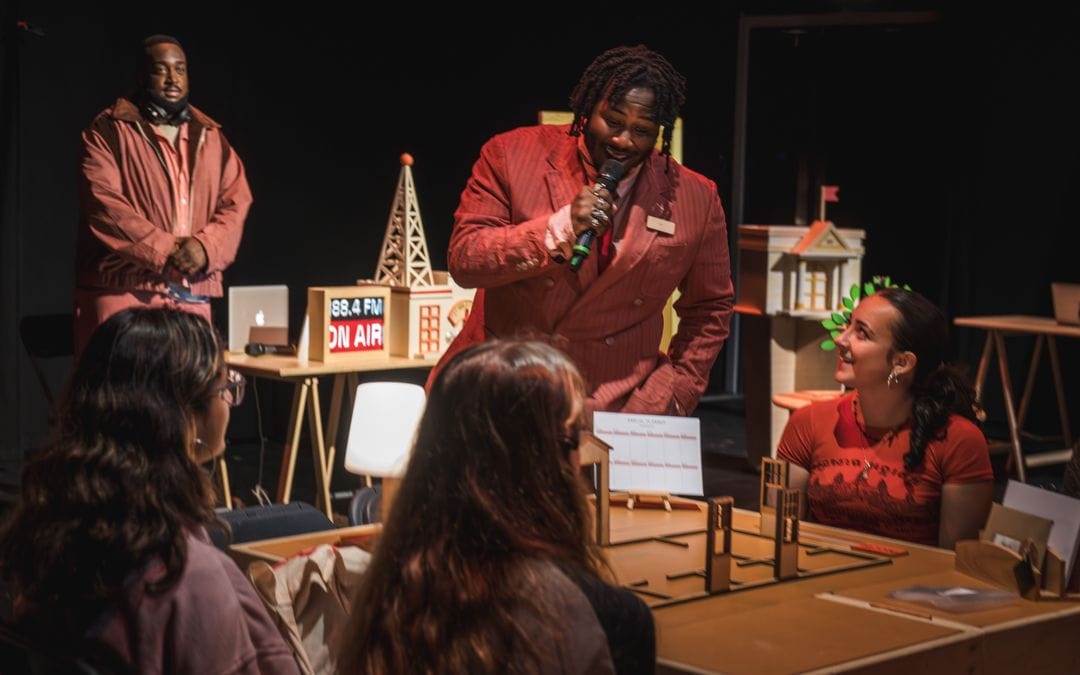Strother Gaines is the Artistic Director & Creator of TBD Immersive, who first showed up on NoPro’s radar with In Cabaret We Trust earlier this year. Based out of Washington DC, TBD (Tradition Be Damned) Immersive believes in creating art that blurs the line between audience and performer, where the audience is safe to explore and challenged to step outside their comfort zone.
We start off by asking Strother NoPro’s Immersive 5 questions — the core questions we are asking immersive creators about what the word “immersive” means to them and how it impacts their work. After that, you’ll find a transcript of Strother’s Ask Me Anything answers; content has been edited for clarity.
If you’d like to join future AMAs, sign up for our Slack forum!
The Immersive 5
No Proscenium: What does “immersive” mean to you?
Strother Gaines (SG): Such a big question to start off with. To me, “immersive” means the audience can 1) imagine themselves as participants in the world even if it’s as an “elevated observer” which 2) means they can influence what their experience during the show is (and sometimes the actual outcome of the performance) which is made easier by 3) creating as separate a world from the actual world as best you, as the creator, can.
We aim to have some type of portal into the world for all our shows (sometimes this is more successful than others) and I think that transition is important. Even if we’re still in the same time period, some demarcation that we’ve left the current world as we know it behind and now we’re somewhere else. I don’t want to have a newspaper from today (or the equivalent) anywhere in the set unless it’s there intentionally as a “relic from a bygone day” or something like that.
I think “immersive” strives to give audiences/guests/participants/whatever you want to call them as fully fleshed out of a world to play in as you can provide, in the space and time you’ve got to build it. Some of our favorite comments from our last show were when people weren’t sure if people they were talking to were characters in the show or not, because everyone started playing in the same proverbial sandbox.
NoPro: Do you think of your work as ‘immersive’? (Why or why not?)
SG: Yup! It’s a big part of the “agency” question which I’ll get into below a bit more. Since the audience does have some sway over their evening and what parts they engage with, I feel like that brings us squarely into the immersive world. Passivity is not rewarded in a TBD show but there is space for even a passive observer to enjoy in their own way.

We try and shape multiple ways for people to engage — whether they’re old-school theatre people, extroverted improvisers, non-theatre folk who just heard there was gonna be a fire breather, or more introverted puzzlers who want to engage but not talk. We try to incorporate artifacts and “silent stories” into our worlds through set, costume, visual artists who create work during the show, clues, journals, news clippings, etc. Our venues are also always mega important and they have had feelings of otherworldliness to them too: a de-sanctified church, four stories of an old row house in downtown DC, abandoned underground trolley tunnels in Dupont Circle, etc. The venue being a character in itself influences all of our choices for the story and the character arcs. It adds to the idea that you’ve immersed yourself in something unique and special.
NoPro: How big a role do presence and/or agency play in your work, and do you think about these factors in those terms?
SG: Agency is really important to us at TBD. We want an audience member to be as in control of their experience as they can be, while playing within the rules of the world we’re building. It’s our hope to make it feel like you could do just about anything in our shows, but we also obviously have ways we are encouraging people to behave. I played a lot of video games in my childhood and I think I’ll always be influenced by that in this work. The closer we can get to an open world-vibe the better. That’s a challenge, though, when you have people who come in who just want to “break the game,” so to speak. So we obviously have to find the places we want to put boundaries or guidelines. While there are obviously limits to how far we can let someone go (we had an audience member go on stage and check a dead character’s pulse to confirm we hadn’t actually been murdering an actor every night; we then blocked off that stage area after the “execution”), we do want people to feel like we’re not necessarily guiding them with our invisible hand whenever possible. (Or when we do, they’re welcoming that guidance or hoping for some structure.)
Regarding “presence” (and I’m reading that to mean “is the audience here with the performer and we can see them or an invisible presence), we try and find creative ways to let audience members know if they’re “present right now” or not for characters. Scenes that take place in rooms you can’t access but can view through a window, for instance. These have an element of “we’re flies on the wall for this one,” whereas the scene in the backstage dressing room, our actors notice the second you walk in and comment on it. “Who let you back here?”
For more private moments or secret spots, we try to work the audience in through some type of invitation or promise to keep what they’re seeing to themselves. This does definitely present some wonky challenges as you’re figuring out how to convey certain things that characters wouldn’t be thrilled about telegraphing widely, when those revelations are key plot points.

NoPro: What works — be they creative works, non-fiction, or other inspirations — have shaped your current work?
SG: When I was in undergrad, I studied abroad in London and I saw The Shunt Collective’s Tropicana in the London Underground. (The irony that our next show is taking place in an underground tunnel is not lost on me.) And it blew my little theatre major mind wide open. I had never seen anything like that before and I was so excited by that style of work that directly engaged me as an audience member. I still have the wrapper from the Kendal Mint Cake they gave me at the beginning of the show to prepare us for “the long journey ahead.”
The next time I was blown away like that was Sleep No More which re-ignighted my excitement for immersive work. At the time though, I wasn’t really producing work, so it just sorta got in my brain and sat there for a while. I took a bit of a break from theatre for a few years and did some stuff like working at the spy museum, as a segway tour guide, became a massage therapist, worked in tech sales, a stint in healthcare…I was a bit of a hummingbird.
I think I also get a lot of my aesthetic and sensibility from sideshow, variety, burlesque, and specifically drag. My drag name is JoAnn Fabrics (I keep the beard) and I have found so much excitement in the drag community. It’s super freeing and I am sure I became a better director when I started doing drag.
Living in DC you can’t really escape politics (nor would I want to) so I know that the political climate always influences where my brain is at too. Through some weird combo of drag, politics, glitter, improv, and sideshow you end up with a TBD production.
NoPro: What was the moment when you knew that this kind of work was for you?
SG: I think it got started back in the London Underground… I just didn’t know how to even approach something like immersive work. I was approached by an ambassador from TEDxMidAtlantic after she saw a show I directed for the Capital Fringe Festival (The House of Yes) and she loved it. She said they’d be thinking of doing some sort of immersive somethin’ somethin’ for their afterparty and wanted to know if I would take a stab at it. I immediately thought of Tropicana and jumped at the chance. Also how cool would it be to have TEDx as a client of mine? So I pulled together my rag-tag group of performers, writers, choreographers, improvisers, sideshow folk, and dancer and we built Welcome to the Family for the TEDxMidAtlantic 2016 afterparty.
We signed on August 3rd to create it, and we got it up and together by October 21st. (There seems to be a TBD theme of “OH GOD WE HAVE 2 MONTHS!” but the three of us on the Artistic Team are all pretty deadline driven so maybe this is helpful for us?)
At the party, everyone was coming up to me saying how cool it was and asking if we were a company here in DC. We had to say “Well, not yet, but would you come see shows if we were?” And then we started talking about getting a company started.
The AMA

Kathryn Yu: What inspired your show “In Cabaret We Trust”?
SG: I poked on this in another question but we were definitely inspired by the election.
Being right in the epicenter of it all (DC voted something like 98% Democrat and that holds true year after year) the sense of “WTF just happened?” was palpable. Lots of artists started to rally around creating work in response and in resistance to the new administration. We wanted to explore the idea of what would happen to DC specifically if we continue down this path.
Obviously we’re taking creative licenses and making leaps that hopefully wouldn’t happen, but in a sort of Handmaid’s Tale sort of way we just kept digging into the xenophobia, nationalism, populism ideology that had been emerging.
The last time we saw something like that forming in such intensity was really in WWII and the Weimar Republic was the precursor. There’s a phrase that “history doesn’t repeat itself but it often rhymes,” and we were trying to look at the excess and progressiveness of the Weimar Republic in stark contrast to the rise of the Nazi power and see how that grafted on to where we were now.
Eight years of “hope and change” and intense progressivism followed by a charismatic leader preaching blood and soil… it wasn’t that far of a stretch for us to make.
Leonie Reynolds: How do you judge how far to go outside the audience comfort zone?
SG: We try to push that boundary as far as we can get away with, but also make sure that people feel like they’re super safe. We always incorporate some area of the venue as a marked “safe spot” if you are feeling overwhelmed by people coming up and talking to you or asking you to complete missions. (Usually near the bar…)
Because a huge portion of the evening is improvised, our performers are all really great at reading how someone is responding to them. Is this person ready to go a bit further? Great, we’ll ask more of them. Is this person really not having it with this burlesque number? We won’t bring them to the orgy later…
Building in different check points and training our performers in reading how people are responding allows us to pivot in the moment and help push just the right amount.
Matthew Bamberg-Johnson: How do you strike a balance between cultivating audience agency and also maintaining control over a desired outcome/narrative pathway?
SG: We’re always experimenting with that and I tend to lean into the “LET EM TRY AND WE’LL FIGURE IT OUT” mindset… much to the chagrin of my Director of Story, Jenny. 😀
I think it’s a part we’re still figuring out the right balance of. Some of the feedback from our last show was some of the objectives we’d give, missions they’d solve, or puzzles they’re work on, didn’t have a big payoff at the end. I think we may have just swung too far into the “whatever you want” side of things. In this next iteration, we’re trying to make sure that all those bits are more connected to storyline or character based payoffs.
We were compared (and I nearly peed myself) to a TellTale game where, at the end of the day, the choice point comes down to a limited number of options, even though the rest of the build has felt like you had a lot more choices to make. Because so much is happening at once, we have to let go of the idea that the audience will all get the same narrative throughline.
We build the world and flesh out the character arcs and then drop the audience in the middle of it. What they catch and the lines they connect falls a bit on them. You could spend your whole night chasing a ghost of the underground and never really engage in the primary conflict point in our “main story line.” If you’re into the ghost world, we say go for it. You can always come back and be more intentional on the story. The first show can be a bit overwhelming, so we definitely do recommend people come back and we try to reward repeat audience members with more Easter eggs and deeper understandings/interactions.

Andrew Lowe: What do you think is unique about the audience and creators of immersive work in Washington DC? Specifically what are some advantages you’ve found to staging work there and what are some disadvantages/challenges you think might be unique to the area?
SG: For In Cabaret We Trust, we were really committed to making sure it happened in the Capital. Our tagline was “May Our Joy be an Act of Resistance” and (as many in this community I’m sure did) we were inspired to create something in response to the election. By using the Weimar Republic era (a time period I’ve always been enthralled by) and populism/nationalism as our jumping off point we knew we wanted to touch on those themes in DC… kinda the eye-of-the-storm type thing.
For challenges in DC, there is very little immersive work here. You have to first explain “immersive” and then your specific show. I think that the timing now is just right, but it can be intimidating to be the only company dedicated to immersive work. You never know if it’s because the city doesn’t support immersive work (too weird?) or if it’s just been an ignored niche. (We’re, of course, leaning towards the latter.)
I think DC is really ready for exciting new work and we’re really excited to be a part of creating that. Another challenge (which not unique to DC but worth noting) is just the overhead costs. Giant cast sizes, super premium real estate prices, and just a really intense cost of living makes producing the work really challenging without some type of grant or boost o’ cash. We were thankfully awarded the Space4 grant which gave us access to our first major space and then we’ve been able to partner with venues using a ticket split system rather than upfront rental to help mitigate some of that.
Advantages: if no one else is doing it, it’s easy to stand out. Also, to be clear, when I say no one else is doing it, I mean in DC proper. Submersive Productions is in Baltimore, which is about 45 minutes north of here, so we do have theatre in the ecosystem. But there is a pretty intense Baltimore/DC divide. I’ve lived in both Baltimore and DC and while it’s “just a quick train ride away,” people don’t go back and forth between the two as easily as you might think.
Steve Boyle: Let’s go basic: what’s the whole DC immersive scene look like? Who are your local influences? Who is local and awesome, but not necessarily immersive?
SG: I legit have a lot of love for the DC theatre scene. It’s a big enough city that can support lots of different companies and works. But it’s small enough that it’s possible for your work to stand out. “Small” feels like maybe the wrong word, but DC is just geographically smaller than most cities. We’re only 68.34 sq mi in DC proper (thanks Wikipedia) so while the population is pretty dense, the actual geography is pretty compact. We’re the only DC-based theatre company dedicated to immersive work but there are some amazing groups here.
I love Woolly Mammoth Theatre Company. They do really exciting and provocative work. They aren’t afraid to take risks in their show selections and their production value is amazing. The talent they bring in is just top notch. dog & pony dc is a smaller company here that started doing what they call “Audience Integration” style pieces. They’re interactive and I’m super excited to see other companies taking interesting risks into new ways of doing theatre. Flying V Theatre does some really cool contemporary works and I love their creative team. Synetic Theater has some amazing movement work and they’re known for their “silent Shakespeare.” Washington Improv Theatre (WIT) have given us a lot of our mega-talented improvisers. Constellation Theatre Company is producing some great quality contemporary musicals that I am digging’ on. Rorschach Theatre has been a huge inspiration for me, artistically and business-wise. I love Mosaic Theater Company’s commitment to doing provocative and socially relevant work. Keegan, Studio, Arena Stage, Anacostia Playhouse, Capital Fringe, so many. I just really love the DC scene, y’all.
Kathryn Yu: What is the relationship between immersive theatre and cabaret, from your perspective?
SG: The Cabaret as a inspiration point grew out of the Weimar Republic (which as I mentioned somewhere in this I am obsessed with). I have always loved variety shows. There was a venue here in DC called “Palace of Wonder” (RIP 😞) and I saw so many exciting things there. I was always wow-ed by the counter culture you get at shows like that. People just decided they were going to pursue something so outside of the norm and they were gonna do it to the nines. I just love that freedom and individuality. The “fringe” nature of cabaret lends itself really well to immersive work because they both break a lot of conventions and make the audience engage in a different way from a more traditional theatre setting. Don’t get me wrong, I also love more traditional theatre but the excitement, sexiness, uniqueness, and individual freak flag flying-ness of cabaret is super appealing to me.

Leonie Reynolds: What is your development process for creating new worlds — do you have specific questions you ask/methodology in order to flesh it out?
SG: We’ve got a funnel process I think. We start with the big things. What’s the primary conflict. What is the world we’re in? Why do we want to be there? What do we want the audience to walk away with? Sometimes there are a couple different things. What are fun moments we can incorporate into this both story wise and just visually? Do we have space for some type of interesting puzzle or unique moment here? What characters need to be here to tell this story? When it comes to characters we start with archetypes, build some key traits and moments for their arc, then have our actors start to shade in the subtlety during table work.
In our current work, we time everything around the structure of the cabaret main stage. We divide the night into time periods and we have an Excel document (so sexy) that tracks where each character is during each time frame. This allows us to figure out who interacts with who and where. We get these larger movement patterns and archetypal characters set and then really just get up on our feet and see what grows out of it. Sometimes we have to kill our darlings, as a performer finds that their character wouldn’t do what we’ve tagged them to do and we have to remain as flexible as we can.
I would be remiss to not mention we have a lot of Google Docs flying all over the damn place.
Kathryn Yu: Why did you name your company “TBD Immersive”?
SG: We had no company name and we were being pressed by our presenting organization to come up with our name and I wrote “TBD” in the blank and was like “Hmmmmm…” I took it to my creative team and they thought it could be confusing or look like we weren’t prepared but I loved it by this point.
We agreed on naming it “TBD” as long as we gave it the “Immersive” tag on the end, as well as making sure it stood for something other than To Be Determined. So technically we’re Tradition Be Damned Immersive when you write it all out. We thought the play would let audience know they got to determine where they were going that night and also we were breaking some conventions with our work.
TBD Immersive’s next show is expected to open in Washington, DC in February 2018. Sign up for their mailing list for future announcements.
View all of our Immersive 5 Interviews.
No Proscenium is a labor of love made possible by our generous backers like you: join them on Patreon today!
In addition to the No Proscenium web site, our podcast, and our newsletters, you can find NoPro on Twitter, Facebook, YouTube, Instagram, in our online community Everything Immersive, and on our Slack forum.




















Discussion